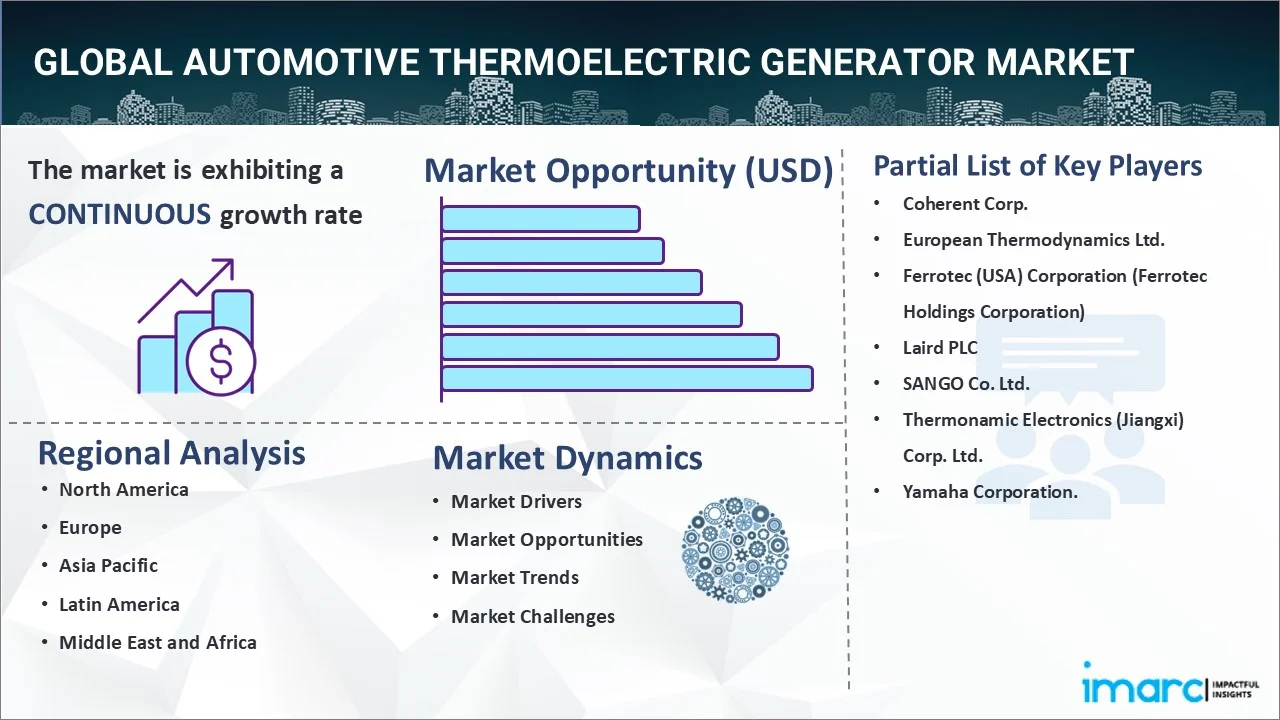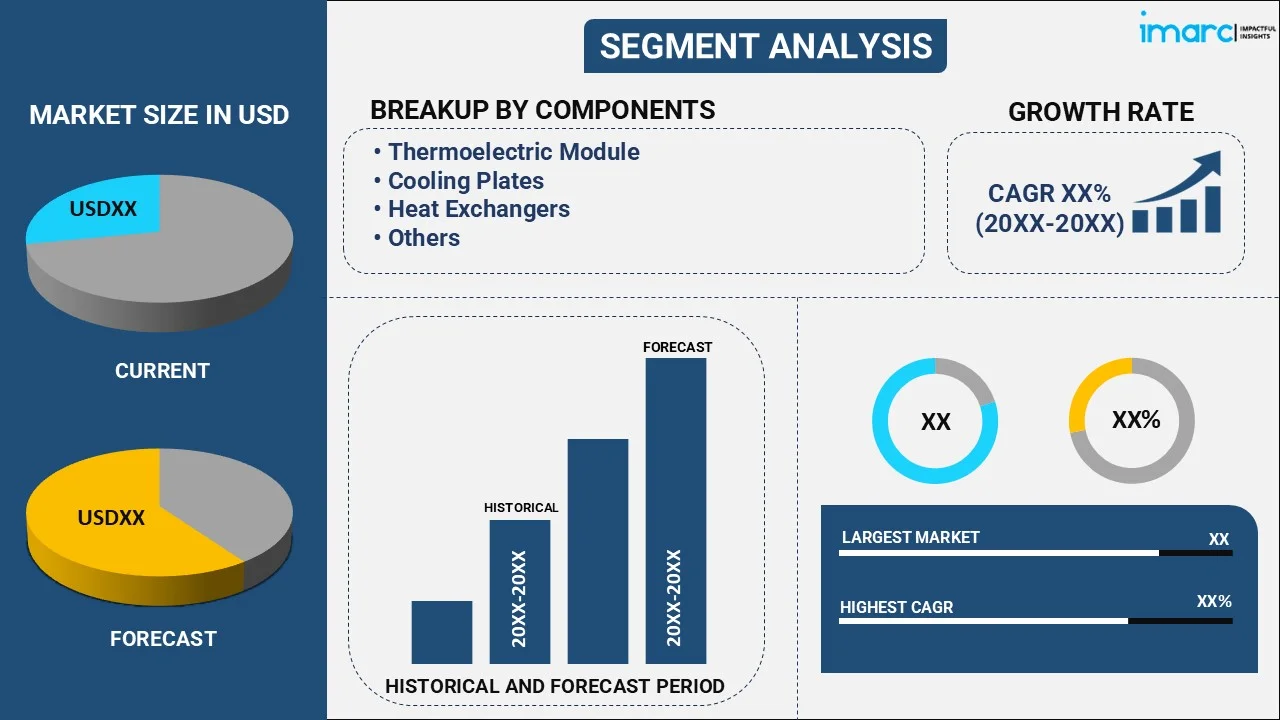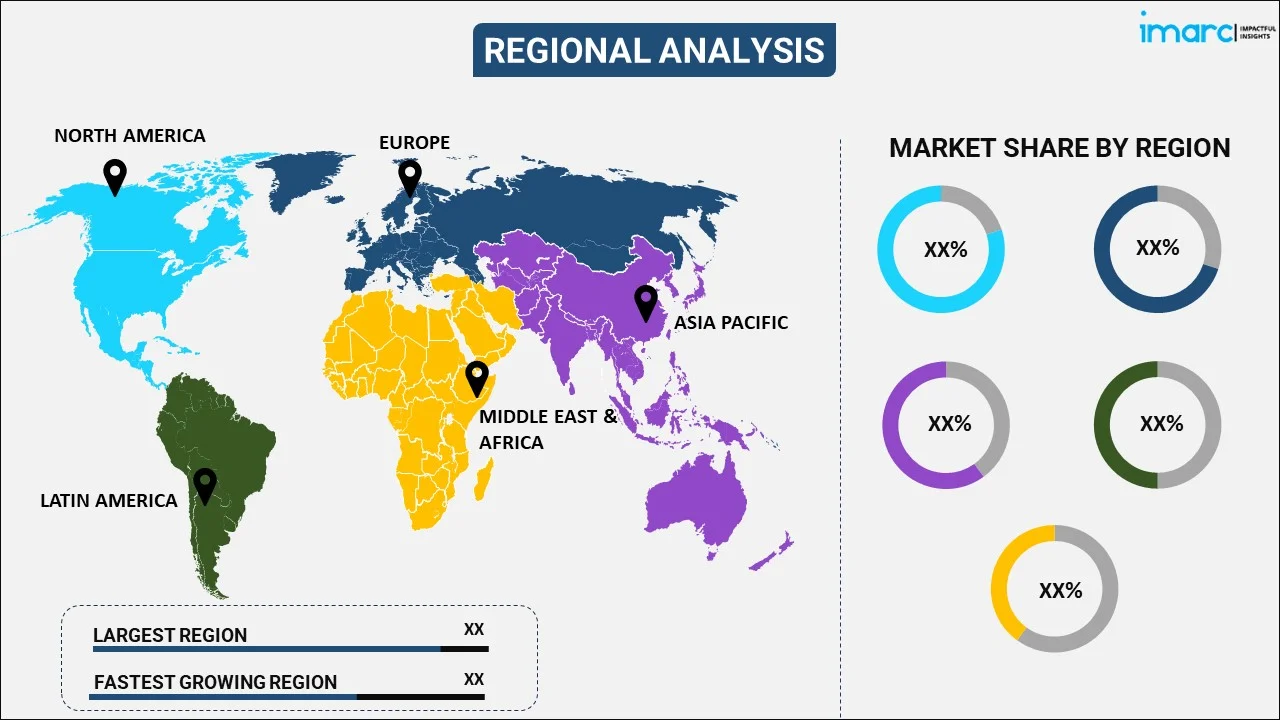
Automotive Thermoelectric Generator Market Report by Component (Thermoelectric Module, Cooling Plates, Heat Exchangers, and Others), Material (Magnesium Silicide, Bismuth Telluride (Bi2Te3), Lead Telluride (PbTe), Skutterudite), Vehicle Type (Passenger Cars, Commercial Vehicles), Application (Waste Heat Recovery, Energy Harvesting, Direct Power Generation, Co-generation), and Region 2025-2033
Global Automotive Thermoelectric Generator Market:
The global automotive thermoelectric generator market size reached USD 49.7 Million in 2024. Looking forward, IMARC Group expects the market to reach USD 122.2 Million by 2033, exhibiting a growth rate (CAGR) of 9.98% during 2025-2033. The inflating need for fuel-efficient vehicles is stimulating the market.
|
Report Attribute
|
Key Statistics
|
|---|---|
|
Base Year
|
2024
|
|
Forecast Years
|
2025-2033
|
|
Historical Years
|
2019-2024
|
|
Market Size in 2024
|
USD 49.7 Million |
|
Market Forecast in 2033
|
USD 122.2 Million |
| Market Growth Rate 2025-2033 | 9.98% |
Automotive Thermoelectric Generator Market Analysis:
- Major Market Drivers: The introduction of thin film thermoelectric generators for automotive applications that enable greater efficiency, scalability, and cost-effectiveness is propelling the market.
- Key Market Trends: The rising environmental concerns leading to extensive product utilization are acting as significant growth-inducing factors.
- Competitive Landscape: Some of the major market companies include Coherent Corp., European Thermodynamics Ltd., Ferrotec (USA) Corporation (Ferrotec Holdings Corporation), Laird PLC, SANGO Co. Ltd., Thermonamic Electronics (Jiangxi) Corp. Ltd., and Yamaha Corporation, among many others.
- Geographical Trends: The increasing emphasis on automotive electrification and energy recovery technologies, as well as major investments in R&D, is augmenting the market in North America.
- Challenges and Opportunities: The high cost of materials and manufacturing is hampering the market. However, advancing material science and scaling production to lower costs while enhancing efficiency will continue to catalyze the market over the forecast period.

Automotive Thermoelectric Generator Market Trends:
Adoption of Waste Heat Recovery Systems
The automotive industry is currently focusing on incorporating generators that produce heat into exhaust systems to convert waste heat into electrical energy. This technique improves vehicle efficiency by powering onboard electronics while lowering reliance on traditional energy sources. In March 2024, the START project aimed to develop sustainable tellurium-free thermoelectric (TE) devices for waste heat recovery applications from secondary mineral resources (mining waste). This is increasing the automotive thermoelectric generator market growth.
Focus on Advancements in Thermoelectric Materials
Recent advancements in materials such as magnesium silicide and bismuth telluride have increased the efficiency and cost-effectiveness of generators for thermal electricity. These generators are ideal for large-scale automotive applications due to their ability to operate at higher temperatures and convert more energy. In September 2024, First Tellurium Corp. reported that its majority-owned subsidiary PyroDelta Energy had launched an initiative to produce thermoelectric generators for automobiles. The device is expected to replace alternators and increase efficiency for combustion engines while also helping electric vehicles generate more power.
Growth in Demand for Environmentally Friendly Thermoelectric Generators
The market is seeing a growth in demand for environmentally friendly materials such as magnesium silicide and bismuth telluride, which allow for efficient energy conversion from waste heat while minimizing environmental impact. This is consistent with the industry's emphasis on sustainability and reduced emissions. In January 2024, in research titled ‘Inverse-Perovskite Ba3BO as a High Performance Environmentally Benign Thermoelectric Material with Low Lattice Thermal Conductivity,’ published in Advanced Science, Tokyo Tech scientists reported on environmentally benign inverse-perovskites with high energy conversion efficiency and potential for practical application as thermoelectric materials.
Global Automotive Thermoelectric Generator Industry Segmentation:
IMARC Group provides an analysis of the key trends in each segment of the market, along with the automotive thermoelectric generator market forecasts at the global, regional, and country levels for 2025-2033. Our report has categorized the market based on component, material, vehicle type, and application.
Breakup by Component:

- Thermoelectric Module
- Cooling Plates
- Heat Exchangers
- Others
The report has provided a detailed breakup and analysis of the market based on the component. This includes thermoelectric module, cooling plates, heat exchangers, and others.
The thermoelectric module is the central component of an automotive thermoelectric generator, which converts waste heat from the vehicle's exhaust into electrical power. Cooling plates help to regulate the heat produced during energy conversion. Heat exchangers transport heat from the vehicle's exhaust pipe to the thermoelectric module. This represents the automotive thermoelectric generator market outlook.
Breakup by Material:
- Magnesium Silicide
- Bismuth Telluride (Bi2Te3)
- Lead Telluride (PbTe)
- Skutterudite
Currently, magnesium silicide holds the largest share in the automotive thermoelectric generator market
The report has provided a detailed breakup and analysis of the market based on the material. This includes magnesium silicide, bismuth telluride (Bi2Te3), lead telluride (PbTe), and skutterudite. According to the report, magnesium silicide represents the largest market segmentation.
The magnesium silicide material gained traction, owing to its remarkable efficiency of converting waste heat from car exhausts into electricity, increasing fuel efficiency and cutting pollutants. Its high-temperature performance makes it an excellent choice for thermoelectric modules in automobile energy recovery systems.
Breakup by Vehicle Type:
- Passenger Cars
- Commercial Vehicles
Among these, passenger cars currently hold the largest automotive thermoelectric generator market demand
The report has provided a detailed breakup and analysis of the market based on the vehicle type. This includes passenger cars and commercial vehicles. According to the report, passenger cars represent the largest market segmentation.
Passenger cars are preferred due to the automotive thermoelectric generator industry’s focus on increasing fuel efficiency and lowering pollutants by turning waste heat into electrical energy. This technology powers auxiliary systems in passenger cars helping to improve energy recovery and meet environmental rules without adding excessive weight.
Breakup by Application:
- Waste Heat Recovery
- Energy Harvesting
- Direct Power Generation
- Co-generation
The report has provided a detailed breakup and analysis of the market based on the application. This includes waste heat recovery, energy harvesting, direct power generation, and co-generation.
As per the automotive thermoelectric generator market forecast report, waste heat recovery focuses on transforming exhaust heat into usable energy, which improves vehicle economy. Energy harvesting uses ambient energy from various sources to power auxiliary equipment. Direct power generation generates electrical energy directly from thermoelectric conversion for use in onboard electronics. Co-generation combines heat recovery with electricity generation, increasing total energy efficiency and lowering car emissions.
Breakup by Region:

- North America
- United States
- Canada
- Asia-Pacific
- China
- Japan
- India
- South Korea
- Australia
- Indonesia
- Others
- Europe
- Germany
- France
- United Kingdom
- Italy
- Spain
- Russia
- Others
- Latin America
- Brazil
- Mexico
- Others
- Middle East and Africa
North America currently dominates the market
The automotive thermoelectric generator market research report has also provided a comprehensive analysis of all the major regional markets, which include North America (the United States and Canada); Asia-Pacific (China, Japan, India, South Korea, Australia, Indonesia, and others); Europe (Germany, France, the United Kingdom, Italy, Spain, Russia, and others); Latin America (Brazil, Mexico, and others); and the Middle East and Africa. According to the report, North America accounted for the largest market share.
North America exhibits a clear dominance in the market driven by increased environmental laws and a push for better fuel efficiency. This technique aids in generating waste heat from vehicles into electrical power, allowing automakers to meet severe emissions rules.
Competitive Landscape:
The automotive thermoelectric generator market outlook report has provided a comprehensive analysis of the competitive landscape. Detailed profiles of all major market companies have also been provided. Some of the key players in the market include:
- Coherent Corp.
- European Thermodynamics Ltd.
- Ferrotec (USA) Corporation (Ferrotec Holdings Corporation)
- Laird PLC
- SANGO Co. Ltd.
- Thermonamic Electronics (Jiangxi) Corp. Ltd.
- Yamaha Corporation
(Please note that this is only a partial list of the key players, and the complete list is provided in the report.)
Automotive Thermoelectric Generator Market Recent Developments:
- September 2024: First Tellurium Corp. reported that its majority-owned subsidiary PyroDelta Energy had launched an initiative to produce thermoelectric generators for automobiles. The device is expected to replace alternators and increase efficiency for combustion engines while also helping electric vehicles generate more power.
- March 2024: The START project aimed to develop sustainable tellurium-free thermoelectric (TE) devices for waste heat recovery applications from secondary mineral resources (mining waste).
- January 2024: In research titled ‘Inverse-Perovskite Ba3BO as a High Performance Environmentally Benign Thermoelectric Material with Low Lattice Thermal Conductivity,’ published in Advanced Science, Tokyo Tech scientists reported on environmentally benign inverse-perovskites with high energy conversion efficiency and potential for practical application as thermoelectric materials.
Automotive Thermoelectric Generator Market Report Scope:
| Report Features | Details |
|---|---|
| Base Year of the Analysis | 2024 |
| Historical Period | 2019-2024 |
| Forecast Period | 2025-2033 |
| Units | Million USD |
| Scope of the Report | Exploration of Historical Trends and Market Outlook, Industry Catalysts and Challenges, Segment-Wise Historical and Predictive Market Assessment:
|
| Components Covered | Thermoelectric Module, Cooling Plates, Heat Exchangers, Others |
| Materials Covered | Magnesium Silicide, Bismuth Telluride (Bi2Te3), Lead Telluride (PbTe), Skutterudite |
| Vehicle Types Covered | Passenger Cars, Commercial Vehicles |
| Applications Covered | Waste Heat Recovery, Energy Harvesting, Direct Power Generation, Co-generation |
| Regions Covered | Asia Pacific, Europe, North America, Latin America, Middle East and Africa |
| Countries Covered | United States, Canada, Germany, France, United Kingdom, Italy, Spain, Russia, China, Japan, India, South Korea, Australia, Indonesia, Brazil, Mexico |
| Companies Covered | Coherent Corp., European Thermodynamics Ltd., Ferrotec (USA) Corporation (Ferrotec Holdings Corporation), Laird PLC, SANGO Co. Ltd., Thermonamic Electronics (Jiangxi) Corp. Ltd., Yamaha Corporation., etc. |
| Customization Scope | 10% Free Customization |
| Post-Sale Analyst Support | 10-12 Weeks |
| Delivery Format | PDF and Excel through Email (We can also provide the editable version of the report in PPT/Word format on special request) |
Key Benefits for Stakeholders:
- IMARC's industry report offers a comprehensive quantitative analysis of various market segments, historical and current market trends, market forecasts, and dynamics of the automotive thermoelectric generator market from 2019-2033.
- The research report provides the latest information on the market drivers, challenges, and opportunities in the global automotive thermoelectric generator market.
- The study maps the leading, as well as the fastest-growing, regional markets. It further enables stakeholders to identify the key country-level markets within each region.
- Porter's five forces analysis assists stakeholders in assessing the impact of new entrants, competitive rivalry, supplier power, buyer power, and the threat of substitution. It helps stakeholders to analyze the level of competition within the automotive thermoelectric generator industry and its attractiveness.
- The competitive landscape allows stakeholders to understand their competitive environment and provides insight into the current positions of key players in the market.
Key Questions Answered in This Report
The global automotive thermoelectric generator market was valued at USD 49.7 Million in 2024.
We expect the global automotive thermoelectric generator market to exhibit a CAGR of 9.98% during 2025-2033.
The rising demand for fuel-efficient vehicles, along with the introduction of thin film thermoelectric generators for automotive applications that provide enhanced efficiency, scalability, cost-effectiveness, etc., is primarily driving the global automotive thermoelectric generator market.
The sudden outbreak of the COVID-19 pandemic had led to the implementation of stringent lockdown regulations across several nations resulting in temporary closure of numerous automobile manufacturing units, thereby negatively impacting the global market for automotive thermoelectric generators.
Based on the material, the global automotive thermoelectric generator market has been divided into magnesium silicide, Bismuth Telluride (Bi2Te3), Lead Telluride (PbTe), and skutterudite. Among these, magnesium silicide currently holds the majority of the total market share.
Based on the vehicle type, the global automotive thermoelectric generator market can be segmented into passenger cars and commercial vehicles. Currently, passenger cars exhibit a clear dominance in the market.
On a regional level, the market has been classified into North America, Asia-Pacific, Europe, Latin America, and Middle East and Africa, where North America currently dominates the global market.
Some of the major players in the global automotive thermoelectric generator market include Coherent Corp., European Thermodynamics Ltd., Ferrotec (USA) Corporation (Ferrotec Holdings Corporation), Laird PLC, SANGO Co. Ltd., Thermonamic Electronics (Jiangxi) Corp. Ltd., and Yamaha Corporation.
Need more help?
- Speak to our experienced analysts for insights on the current market scenarios.
- Include additional segments and countries to customize the report as per your requirement.
- Gain an unparalleled competitive advantage in your domain by understanding how to utilize the report and positively impacting your operations and revenue.
- For further assistance, please connect with our analysts.
 Inquire Before Buying
Inquire Before Buying
 Speak to an Analyst
Speak to an Analyst
 Request Brochure
Request Brochure
 Request Customization
Request Customization




.webp)




.webp)












